Ugandan vs Scottish Community Comparison
COMPARE
Ugandan
Scottish
Social Comparison
Social Comparison
Ugandans
Scottish
6,220
SOCIAL INDEX
59.7/ 100
SOCIAL RATING
159th/ 347
SOCIAL RANK
6,834
SOCIAL INDEX
65.8/ 100
SOCIAL RATING
139th/ 347
SOCIAL RANK
Scottish Integration in Ugandan Communities
The statistical analysis conducted on geographies consisting of 93,841,152 people shows a moderate positive correlation between the proportion of Scottish within Ugandan communities in the United States with a correlation coefficient (R) of 0.431. On average, for every 1% (one percent) increase in Ugandans within a typical geography, there is an increase of 0.348% in Scottish. To illustrate, in a geography comprising of 100,000 individuals, a rise of 1,000 Ugandans corresponds to an increase of 348.4 Scottish.
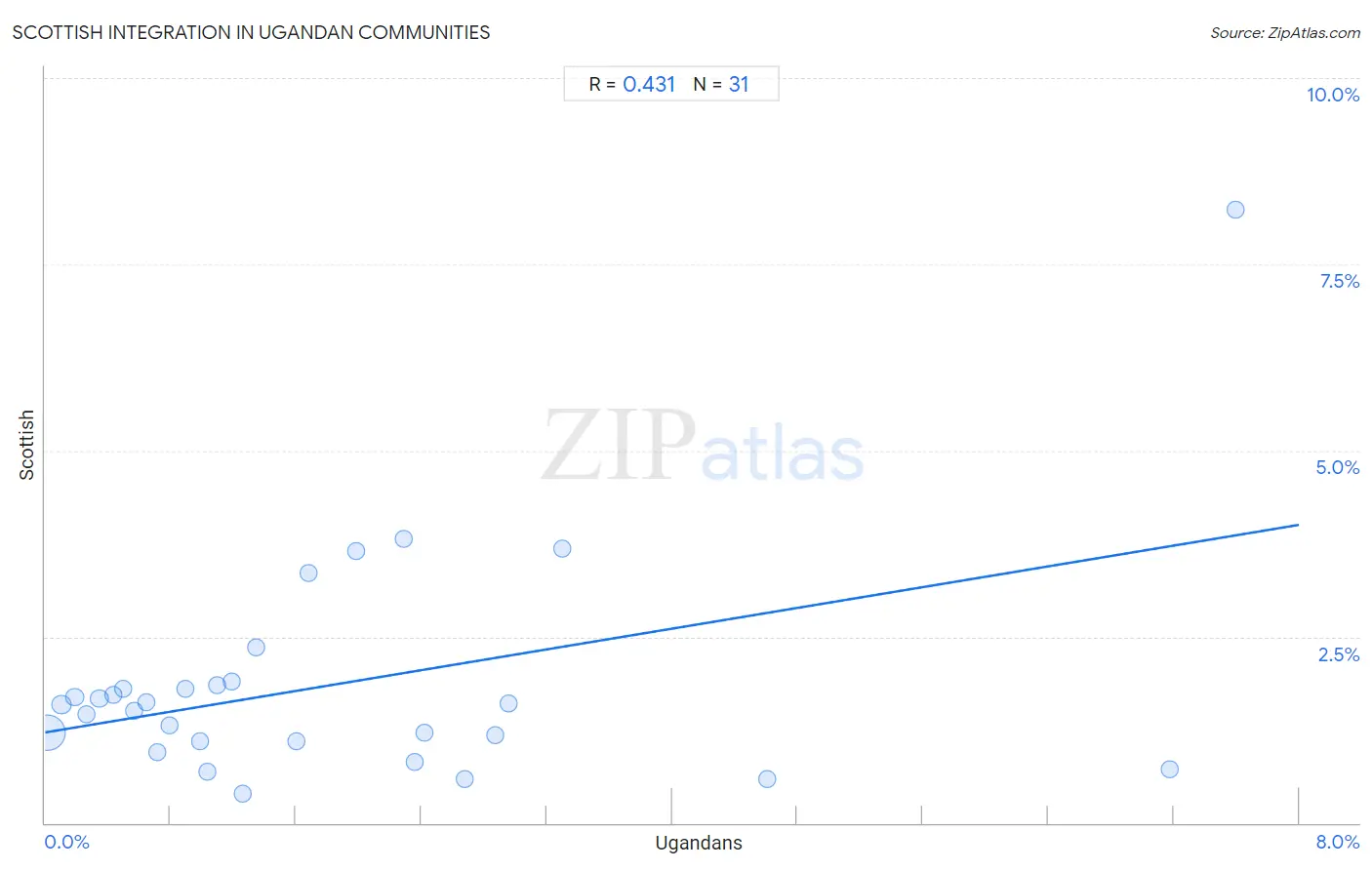
Ugandan vs Scottish Income
When considering income, the most significant differences between Ugandan and Scottish communities in the United States are seen in wage/income gap (24.1% compared to 29.1%, a difference of 21.1%), median female earnings ($40,889 compared to $38,397, a difference of 6.5%), and median earnings ($47,854 compared to $46,463, a difference of 3.0%). Conversely, both communities are more comparable in terms of householder income under 25 years ($50,923 compared to $50,554, a difference of 0.73%), median male earnings ($55,290 compared to $55,793, a difference of 0.91%), and householder income over 65 years ($61,177 compared to $61,735, a difference of 0.91%).

| Income Metric | Ugandan | Scottish |
| Per Capita Income | Excellent $45,047 | Good $44,440 |
| Median Family Income | Excellent $106,541 | Good $104,288 |
| Median Household Income | Excellent $87,557 | Average $85,101 |
| Median Earnings | Excellent $47,854 | Average $46,463 |
| Median Male Earnings | Good $55,290 | Good $55,793 |
| Median Female Earnings | Exceptional $40,889 | Tragic $38,397 |
| Householder Age | Under 25 years | Tragic $50,923 | Tragic $50,554 |
| Householder Age | 25 - 44 years | Good $96,667 | Average $94,622 |
| Householder Age | 45 - 64 years | Excellent $103,472 | Good $102,123 |
| Householder Age | Over 65 years | Average $61,177 | Good $61,735 |
| Wage/Income Gap | Exceptional 24.1% | Tragic 29.1% |
Ugandan vs Scottish Poverty
When considering poverty, the most significant differences between Ugandan and Scottish communities in the United States are seen in married-couple family poverty (5.3% compared to 4.3%, a difference of 25.1%), seniors poverty over the age of 65 (11.4% compared to 9.2%, a difference of 24.6%), and receiving food stamps (12.2% compared to 9.9%, a difference of 24.0%). Conversely, both communities are more comparable in terms of female poverty among 25-34 year olds (13.4% compared to 13.9%, a difference of 3.7%), single mother poverty (28.8% compared to 30.1%, a difference of 4.4%), and single female poverty (20.8% compared to 21.8%, a difference of 4.9%).
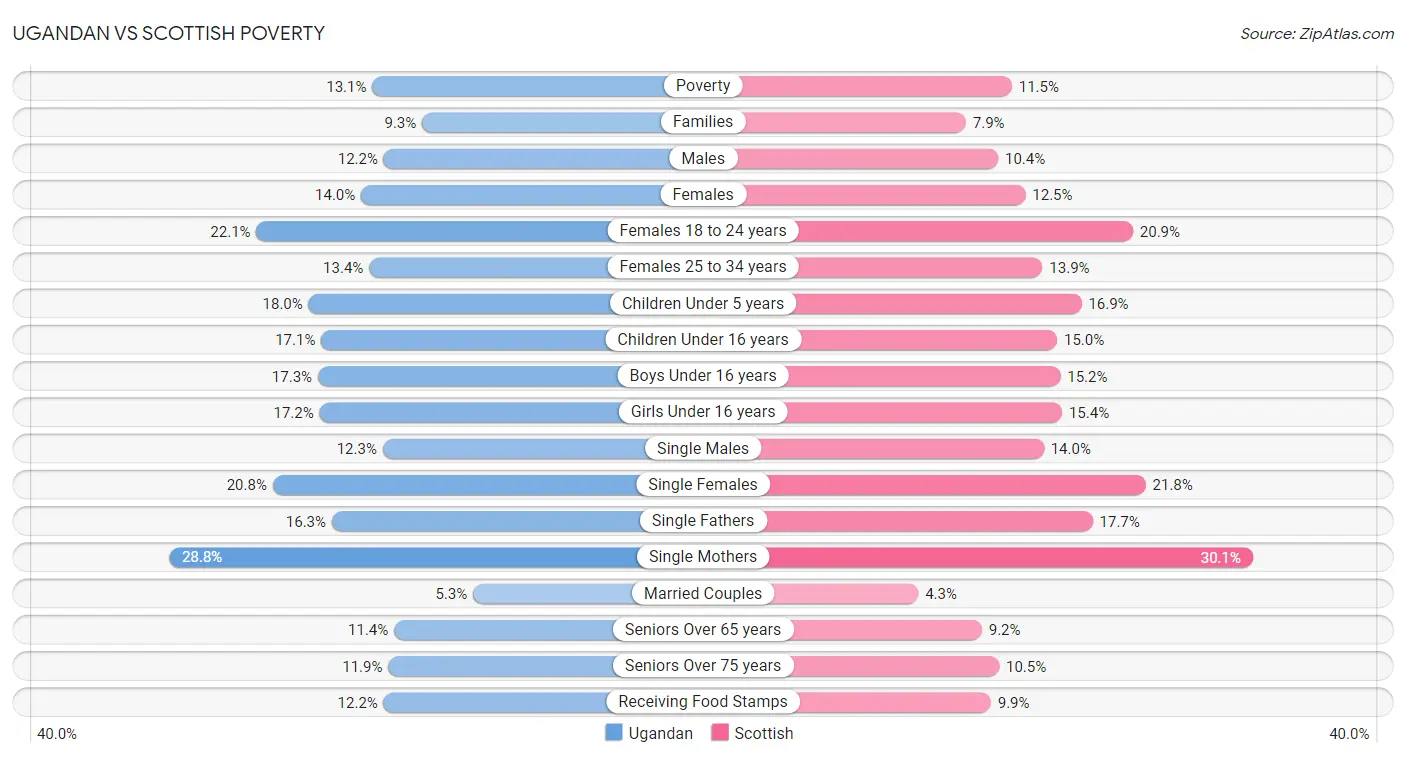
| Poverty Metric | Ugandan | Scottish |
| Poverty | Tragic 13.1% | Exceptional 11.5% |
| Families | Fair 9.3% | Exceptional 7.9% |
| Males | Tragic 12.2% | Exceptional 10.4% |
| Females | Poor 14.0% | Exceptional 12.5% |
| Females 18 to 24 years | Tragic 22.1% | Tragic 20.9% |
| Females 25 to 34 years | Good 13.4% | Fair 13.9% |
| Children Under 5 years | Poor 18.0% | Good 16.9% |
| Children Under 16 years | Poor 17.1% | Exceptional 15.0% |
| Boys Under 16 years | Poor 17.3% | Exceptional 15.2% |
| Girls Under 16 years | Poor 17.2% | Exceptional 15.4% |
| Single Males | Exceptional 12.3% | Tragic 14.0% |
| Single Females | Good 20.8% | Tragic 21.8% |
| Single Fathers | Average 16.3% | Tragic 17.7% |
| Single Mothers | Good 28.8% | Tragic 30.1% |
| Married Couples | Fair 5.3% | Exceptional 4.3% |
| Seniors Over 65 years | Poor 11.4% | Exceptional 9.2% |
| Seniors Over 75 years | Good 11.9% | Exceptional 10.5% |
| Receiving Food Stamps | Fair 12.2% | Exceptional 9.9% |
Ugandan vs Scottish Unemployment
When considering unemployment, the most significant differences between Ugandan and Scottish communities in the United States are seen in unemployment among seniors over 75 years (7.7% compared to 10.1%, a difference of 31.0%), unemployment among women with children ages 6 to 17 years (12.0% compared to 9.4%, a difference of 28.5%), and unemployment among ages 45 to 54 years (4.9% compared to 4.1%, a difference of 18.0%). Conversely, both communities are more comparable in terms of unemployment among ages 55 to 59 years (4.6% compared to 4.5%, a difference of 1.2%), unemployment among ages 65 to 74 years (5.1% compared to 5.2%, a difference of 2.8%), and unemployment among ages 25 to 29 years (6.8% compared to 6.6%, a difference of 2.9%).
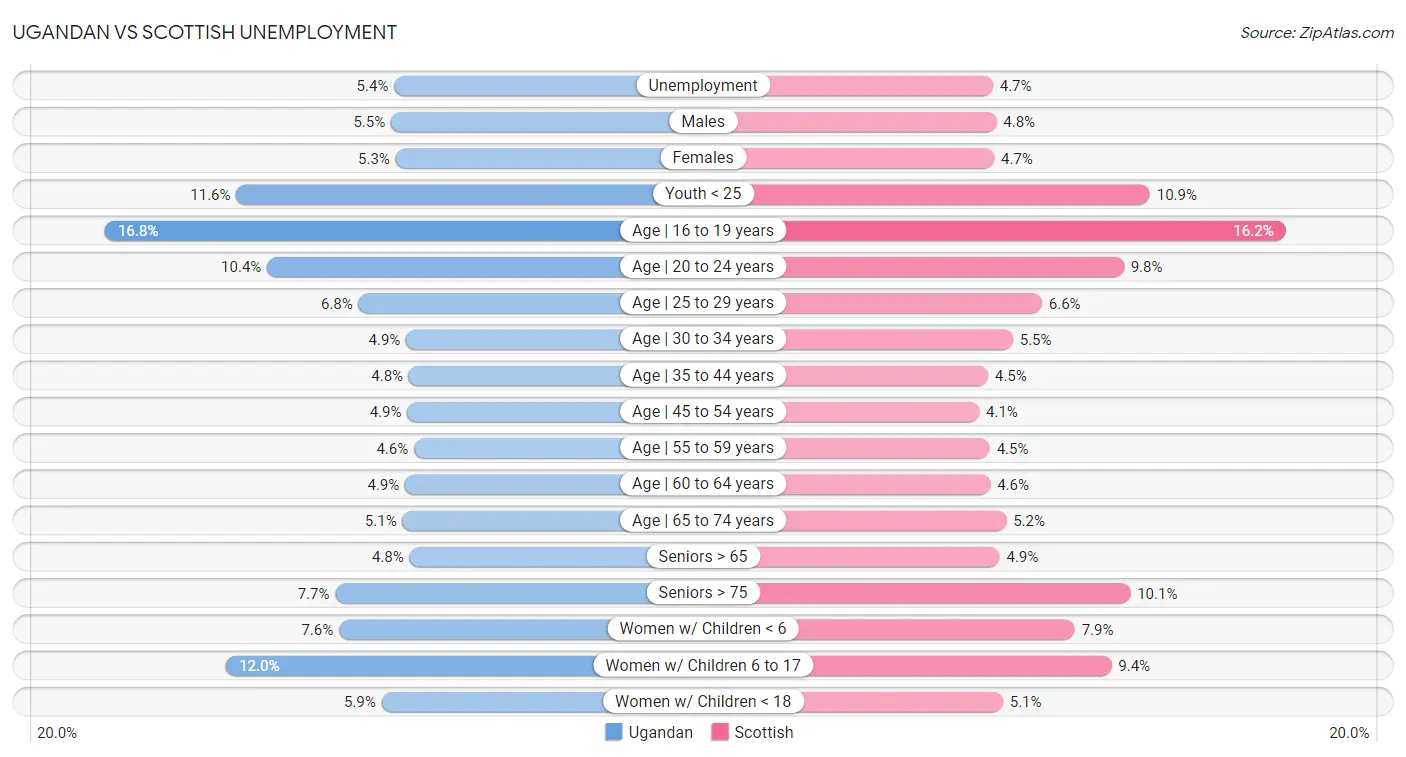
| Unemployment Metric | Ugandan | Scottish |
| Unemployment | Poor 5.4% | Exceptional 4.7% |
| Males | Tragic 5.5% | Exceptional 4.8% |
| Females | Fair 5.3% | Exceptional 4.7% |
| Youth < 25 | Average 11.6% | Exceptional 10.9% |
| Age | 16 to 19 years | Exceptional 16.8% | Exceptional 16.2% |
| Age | 20 to 24 years | Fair 10.4% | Exceptional 9.8% |
| Age | 25 to 29 years | Poor 6.8% | Good 6.6% |
| Age | 30 to 34 years | Exceptional 4.9% | Average 5.5% |
| Age | 35 to 44 years | Fair 4.8% | Exceptional 4.5% |
| Age | 45 to 54 years | Tragic 4.9% | Exceptional 4.1% |
| Age | 55 to 59 years | Exceptional 4.6% | Exceptional 4.5% |
| Age | 60 to 64 years | Poor 4.9% | Exceptional 4.6% |
| Age | 65 to 74 years | Exceptional 5.1% | Exceptional 5.2% |
| Seniors > 65 | Exceptional 4.8% | Exceptional 4.9% |
| Seniors > 75 | Exceptional 7.7% | Tragic 10.1% |
| Women w/ Children < 6 | Good 7.6% | Poor 7.9% |
| Women w/ Children 6 to 17 | Tragic 12.0% | Tragic 9.4% |
| Women w/ Children < 18 | Tragic 5.9% | Exceptional 5.1% |
Ugandan vs Scottish Labor Participation
When considering labor participation, the most significant differences between Ugandan and Scottish communities in the United States are seen in in labor force | age 16-19 (38.9% compared to 42.0%, a difference of 8.1%), in labor force | age > 16 (67.4% compared to 63.9%, a difference of 5.5%), and in labor force | age 20-24 (75.4% compared to 77.4%, a difference of 2.7%). Conversely, both communities are more comparable in terms of in labor force | age 25-29 (85.9% compared to 84.6%, a difference of 1.5%), in labor force | age 35-44 (85.3% compared to 83.9%, a difference of 1.7%), and in labor force | age 45-54 (83.7% compared to 82.2%, a difference of 1.8%).

| Labor Participation Metric | Ugandan | Scottish |
| In Labor Force | Age > 16 | Exceptional 67.4% | Tragic 63.9% |
| In Labor Force | Age 20-64 | Exceptional 80.6% | Tragic 78.9% |
| In Labor Force | Age 16-19 | Exceptional 38.9% | Exceptional 42.0% |
| In Labor Force | Age 20-24 | Good 75.4% | Exceptional 77.4% |
| In Labor Force | Age 25-29 | Exceptional 85.9% | Average 84.6% |
| In Labor Force | Age 30-34 | Exceptional 85.8% | Tragic 84.2% |
| In Labor Force | Age 35-44 | Exceptional 85.3% | Tragic 83.9% |
| In Labor Force | Age 45-54 | Exceptional 83.7% | Tragic 82.2% |
Ugandan vs Scottish Family Structure
When considering family structure, the most significant differences between Ugandan and Scottish communities in the United States are seen in single mother households (6.5% compared to 5.8%, a difference of 12.9%), married-couple households (43.8% compared to 49.0%, a difference of 11.8%), and currently married (44.2% compared to 49.2%, a difference of 11.3%). Conversely, both communities are more comparable in terms of single father households (2.3% compared to 2.3%, a difference of 0.91%), family households with children (27.4% compared to 27.0%, a difference of 1.5%), and average family size (3.23 compared to 3.11, a difference of 4.1%).

| Family Structure Metric | Ugandan | Scottish |
| Family Households | Tragic 61.7% | Good 64.5% |
| Family Households with Children | Average 27.4% | Tragic 27.0% |
| Married-couple Households | Tragic 43.8% | Exceptional 49.0% |
| Average Family Size | Average 3.23 | Tragic 3.11 |
| Single Father Households | Good 2.3% | Good 2.3% |
| Single Mother Households | Fair 6.5% | Exceptional 5.8% |
| Currently Married | Tragic 44.2% | Exceptional 49.2% |
| Divorced or Separated | Exceptional 11.8% | Tragic 12.6% |
| Births to Unmarried Women | Excellent 30.1% | Average 31.7% |
Ugandan vs Scottish Vehicle Availability
When considering vehicle availability, the most significant differences between Ugandan and Scottish communities in the United States are seen in no vehicles in household (11.4% compared to 6.8%, a difference of 68.9%), 4 or more vehicles in household (5.7% compared to 7.4%, a difference of 30.1%), and 3 or more vehicles in household (17.8% compared to 22.6%, a difference of 27.2%). Conversely, both communities are more comparable in terms of 1 or more vehicles in household (88.9% compared to 93.4%, a difference of 5.1%), 2 or more vehicles in household (53.5% compared to 61.2%, a difference of 14.5%), and 3 or more vehicles in household (17.8% compared to 22.6%, a difference of 27.2%).

| Vehicle Availability Metric | Ugandan | Scottish |
| No Vehicles Available | Tragic 11.4% | Exceptional 6.8% |
| 1+ Vehicles Available | Tragic 88.9% | Exceptional 93.4% |
| 2+ Vehicles Available | Tragic 53.5% | Exceptional 61.2% |
| 3+ Vehicles Available | Tragic 17.8% | Exceptional 22.6% |
| 4+ Vehicles Available | Tragic 5.7% | Exceptional 7.4% |
Ugandan vs Scottish Education Level
When considering education level, the most significant differences between Ugandan and Scottish communities in the United States are seen in no schooling completed (2.0% compared to 1.4%, a difference of 44.9%), master's degree (17.1% compared to 15.2%, a difference of 13.0%), and professional degree (5.1% compared to 4.6%, a difference of 12.3%). Conversely, both communities are more comparable in terms of college, under 1 year (66.8% compared to 67.0%, a difference of 0.27%), nursery school (98.0% compared to 98.7%, a difference of 0.68%), and kindergarten (98.0% compared to 98.6%, a difference of 0.68%).
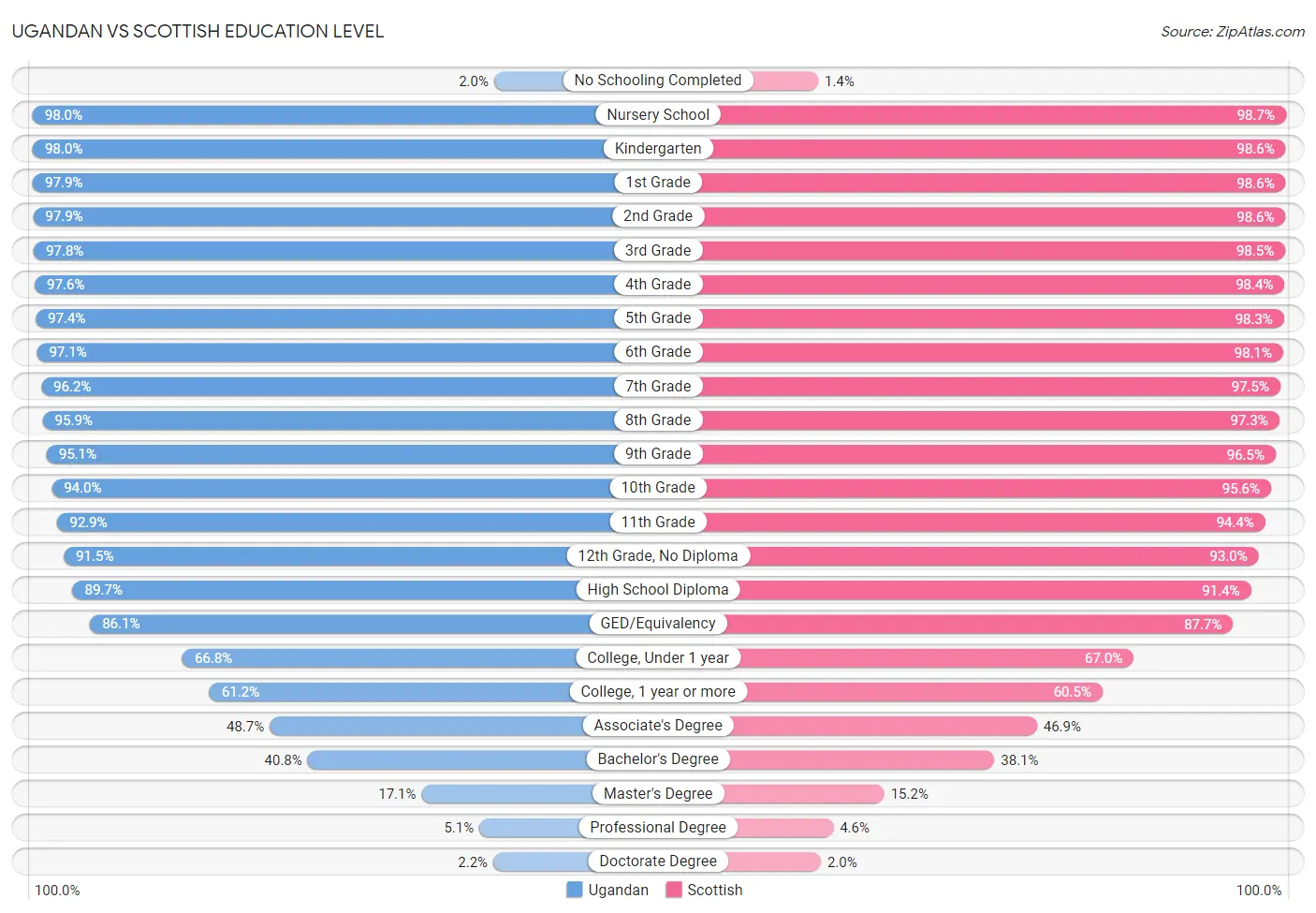
| Education Level Metric | Ugandan | Scottish |
| No Schooling Completed | Good 2.0% | Exceptional 1.4% |
| Nursery School | Average 98.0% | Exceptional 98.7% |
| Kindergarten | Average 98.0% | Exceptional 98.6% |
| 1st Grade | Average 97.9% | Exceptional 98.6% |
| 2nd Grade | Average 97.9% | Exceptional 98.6% |
| 3rd Grade | Average 97.8% | Exceptional 98.5% |
| 4th Grade | Average 97.6% | Exceptional 98.4% |
| 5th Grade | Average 97.4% | Exceptional 98.3% |
| 6th Grade | Good 97.1% | Exceptional 98.1% |
| 7th Grade | Good 96.2% | Exceptional 97.5% |
| 8th Grade | Good 95.9% | Exceptional 97.3% |
| 9th Grade | Good 95.1% | Exceptional 96.5% |
| 10th Grade | Excellent 94.0% | Exceptional 95.6% |
| 11th Grade | Excellent 92.9% | Exceptional 94.4% |
| 12th Grade, No Diploma | Good 91.5% | Exceptional 93.0% |
| High School Diploma | Excellent 89.7% | Exceptional 91.4% |
| GED/Equivalency | Good 86.1% | Exceptional 87.7% |
| College, Under 1 year | Excellent 66.8% | Exceptional 67.0% |
| College, 1 year or more | Exceptional 61.2% | Excellent 60.5% |
| Associate's Degree | Exceptional 48.7% | Good 46.9% |
| Bachelor's Degree | Exceptional 40.8% | Average 38.1% |
| Master's Degree | Exceptional 17.1% | Good 15.2% |
| Professional Degree | Exceptional 5.1% | Good 4.6% |
| Doctorate Degree | Exceptional 2.2% | Excellent 2.0% |
Ugandan vs Scottish Disability
When considering disability, the most significant differences between Ugandan and Scottish communities in the United States are seen in disability age under 5 (1.1% compared to 1.6%, a difference of 44.9%), hearing disability (2.9% compared to 3.7%, a difference of 30.1%), and male disability (11.0% compared to 12.8%, a difference of 16.4%). Conversely, both communities are more comparable in terms of disability age 5 to 17 (6.2% compared to 6.1%, a difference of 0.41%), disability age over 75 (46.3% compared to 46.7%, a difference of 0.99%), and disability age 65 to 74 (22.7% compared to 23.6%, a difference of 3.7%).
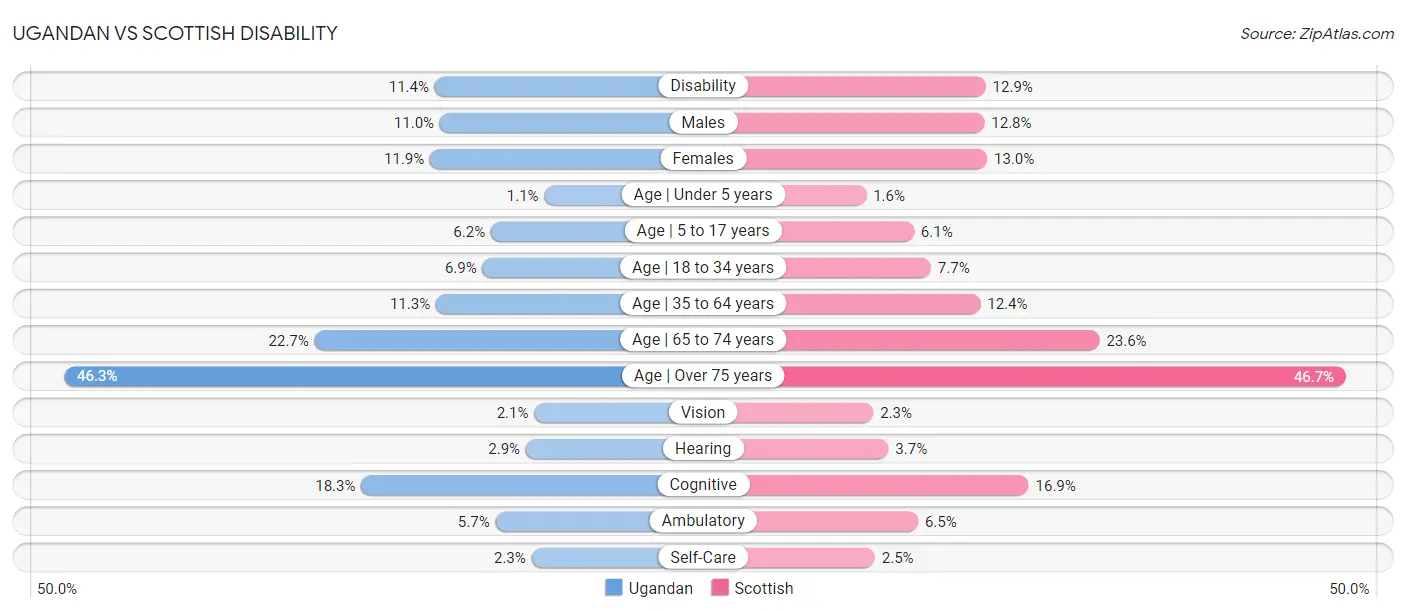
| Disability Metric | Ugandan | Scottish |
| Disability | Excellent 11.4% | Tragic 12.9% |
| Males | Excellent 11.0% | Tragic 12.8% |
| Females | Exceptional 11.9% | Tragic 13.0% |
| Age | Under 5 years | Exceptional 1.1% | Tragic 1.6% |
| Age | 5 to 17 years | Tragic 6.2% | Tragic 6.1% |
| Age | 18 to 34 years | Tragic 6.9% | Tragic 7.7% |
| Age | 35 to 64 years | Average 11.3% | Tragic 12.4% |
| Age | 65 to 74 years | Excellent 22.7% | Fair 23.6% |
| Age | Over 75 years | Exceptional 46.3% | Exceptional 46.7% |
| Vision | Exceptional 2.1% | Tragic 2.3% |
| Hearing | Excellent 2.9% | Tragic 3.7% |
| Cognitive | Tragic 18.3% | Exceptional 16.9% |
| Ambulatory | Exceptional 5.7% | Tragic 6.5% |
| Self-Care | Exceptional 2.3% | Average 2.5% |